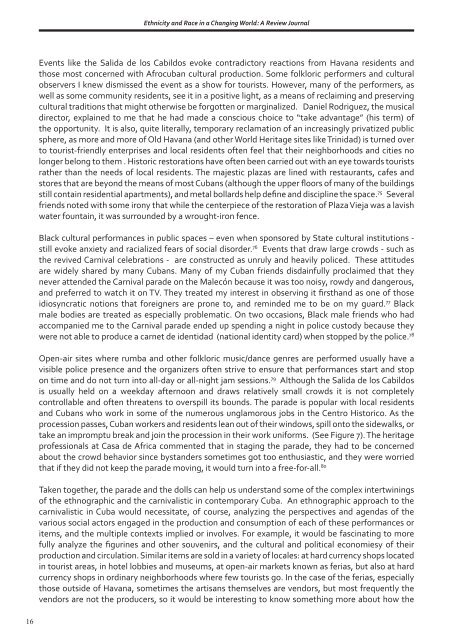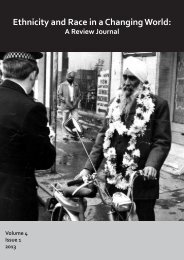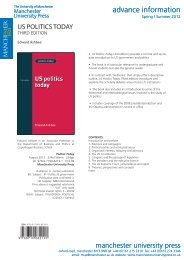Ethnicity and Race in a Changing World
Volume 2, Issue 1, 2011 - Manchester University Press
Volume 2, Issue 1, 2011 - Manchester University Press
Create successful ePaper yourself
Turn your PDF publications into a flip-book with our unique Google optimized e-Paper software.
<strong>Ethnicity</strong> <strong>and</strong> <strong>Race</strong> <strong>in</strong> a Chang<strong>in</strong>g <strong>World</strong>: A Review JournalEvents like the Salida de los Cabildos evoke contradictory reactions from Havana residents <strong>and</strong>those most concerned with Afrocuban cultural production. Some folkloric performers <strong>and</strong> culturalobservers I knew dismissed the event as a show for tourists. However, many of the performers, aswell as some community residents, see it <strong>in</strong> a positive light, as a means of reclaim<strong>in</strong>g <strong>and</strong> preserv<strong>in</strong>gcultural traditions that might otherwise be forgotten or marg<strong>in</strong>alized. Daniel Rodriguez, the musicaldirector, expla<strong>in</strong>ed to me that he had made a conscious choice to “take advantage” (his term) ofthe opportunity. It is also, quite literally, temporary reclamation of an <strong>in</strong>creas<strong>in</strong>gly privatized publicsphere, as more <strong>and</strong> more of Old Havana (<strong>and</strong> other <strong>World</strong> Heritage sites like Tr<strong>in</strong>idad) is turned overto tourist-friendly enterprises <strong>and</strong> local residents often feel that their neighborhoods <strong>and</strong> cities nolonger belong to them . Historic restorations have often been carried out with an eye towards touristsrather than the needs of local residents. The majestic plazas are l<strong>in</strong>ed with restaurants, cafes <strong>and</strong>stores that are beyond the means of most Cubans (although the upper floors of many of the build<strong>in</strong>gsstill conta<strong>in</strong> residential apartments), <strong>and</strong> metal bollards help def<strong>in</strong>e <strong>and</strong> discipl<strong>in</strong>e the space. 75 Severalfriends noted with some irony that while the centerpiece of the restoration of Plaza Vieja was a lavishwater founta<strong>in</strong>, it was surrounded by a wrought-iron fence.Black cultural performances <strong>in</strong> public spaces – even when sponsored by State cultural <strong>in</strong>stitutions -still evoke anxiety <strong>and</strong> racialized fears of social disorder. 76 Events that draw large crowds - such asthe revived Carnival celebrations - are constructed as unruly <strong>and</strong> heavily policed. These attitudesare widely shared by many Cubans. Many of my Cuban friends disda<strong>in</strong>fully proclaimed that theynever attended the Carnival parade on the Malecón because it was too noisy, rowdy <strong>and</strong> dangerous,<strong>and</strong> preferred to watch it on TV. They treated my <strong>in</strong>terest <strong>in</strong> observ<strong>in</strong>g it firsth<strong>and</strong> as one of thoseidiosyncratic notions that foreigners are prone to, <strong>and</strong> rem<strong>in</strong>ded me to be on my guard. 77 Blackmale bodies are treated as especially problematic. On two occasions, Black male friends who hadaccompanied me to the Carnival parade ended up spend<strong>in</strong>g a night <strong>in</strong> police custody because theywere not able to produce a carnet de identidad (national identity card) when stopped by the police. 78Open-air sites where rumba <strong>and</strong> other folkloric music/dance genres are performed usually have avisible police presence <strong>and</strong> the organizers often strive to ensure that performances start <strong>and</strong> stopon time <strong>and</strong> do not turn <strong>in</strong>to all-day or all-night jam sessions. 79 Although the Salida de los Cabildosis usually held on a weekday afternoon <strong>and</strong> draws relatively small crowds it is not completelycontrollable <strong>and</strong> often threatens to overspill its bounds. The parade is popular with local residents<strong>and</strong> Cubans who work <strong>in</strong> some of the numerous unglamorous jobs <strong>in</strong> the Centro Historico. As theprocession passes, Cuban workers <strong>and</strong> residents lean out of their w<strong>in</strong>dows, spill onto the sidewalks, ortake an impromptu break <strong>and</strong> jo<strong>in</strong> the procession <strong>in</strong> their work uniforms. (See Figure 7). The heritageprofessionals at Casa de Africa commented that <strong>in</strong> stag<strong>in</strong>g the parade, they had to be concernedabout the crowd behavior s<strong>in</strong>ce byst<strong>and</strong>ers sometimes got too enthusiastic, <strong>and</strong> they were worriedthat if they did not keep the parade mov<strong>in</strong>g, it would turn <strong>in</strong>to a free-for-all. 80Taken together, the parade <strong>and</strong> the dolls can help us underst<strong>and</strong> some of the complex <strong>in</strong>tertw<strong>in</strong><strong>in</strong>gsof the ethnographic <strong>and</strong> the carnivalistic <strong>in</strong> contemporary Cuba. An ethnographic approach to thecarnivalistic <strong>in</strong> Cuba would necessitate, of course, analyz<strong>in</strong>g the perspectives <strong>and</strong> agendas of thevarious social actors engaged <strong>in</strong> the production <strong>and</strong> consumption of each of these performances oritems, <strong>and</strong> the multiple contexts implied or <strong>in</strong>volves. For example, it would be fasc<strong>in</strong>at<strong>in</strong>g to morefully analyze the figur<strong>in</strong>es <strong>and</strong> other souvenirs, <strong>and</strong> the cultural <strong>and</strong> political economiesy of theirproduction <strong>and</strong> circulation. Similar items are sold <strong>in</strong> a variety of locales: at hard currency shops located<strong>in</strong> tourist areas, <strong>in</strong> hotel lobbies <strong>and</strong> museums, at open-air markets known as ferias, but also at hardcurrency shops <strong>in</strong> ord<strong>in</strong>ary neighborhoods where few tourists go. In the case of the ferias, especiallythose outside of Havana, sometimes the artisans themselves are vendors, but most frequently thevendors are not the producers, so it would be <strong>in</strong>terest<strong>in</strong>g to know someth<strong>in</strong>g more about how the16






